Roni
Member
Hi,
The previous trip report part:
India 2012 - 14: Thums Up for Ankai Killa! (50 p.)
http://railroadforums.com/forum/showthread.php?t=40077
The accompanying video:
http://www.youtube.com/watch?v=Ln9ntoVBVts&hd=1
February 14 2012
We continue our journey at Manmad where Sachin and Anish had taken me back to town. We parked behind the station where loco crew quarters and other railway buildings were located. Friends of Anish were living here with an elderly doctor who wanted to get me to meditate. We tried to get past the hospitality and soon walked on to the platform.
The southern entrance of Manmad station was much more convenient than the overpopulated northern main entrance.

My first meeting with one of the main Central Railway workhorses in Mumbai region, dual current WCAM-3 21948, built in 1998. From the pedestrian bridge you had a good overview of Manmad station.

My train was the Tuesday only ALCO hauled 12132 express Shirdi Dadar, from April its whole route was supposed to be electrified. I said goodbye to my friends and subsequently could enjoy a ride in not too full AC II class.
I crossed the Western Ghats or Sahyadri for the first time that day, on the steep Thal (or Thull) Ghat section between Igatpuri and Kasara. This mountain range constitutes the western edge of the Deccan Plateau where the main chunk of India is located. A natural barrier which always had to be overcome by railways in early times on the way to the centre and east coast of India. The Thal Ghat mountain section had been opened by the Great Indian Peninsula Railway (GIPR: http://en.wikipedia.org/wiki/Great_Indian_Peninsula_Railway ) in 1865, until recently DC electrified Mumbai - Igatpuri, now AC was ruling the Ghats. As passenger you did not notice this section dominated by steep grades, tall bridges and tunnels that much as it featured hardly any narrow curves.
After a little more than three hours we reached Kalyan almost punctually, main junction of two Central Railway mountain routes northeast of Mumbai and also home shed of Central Railway electric mainline locos in the Mumbai area. It was a chaotic station, jam-packed with passengers, even the waiting room proved to be fuller as it also included Sleeper class travellers. Express trains into various parts of the country arrived every ten minutes, sometimes having to wait until the platform was vacated by the previous express. It seemed to be customary for IR to use as few platforms as possible - this also had positive sides, because frequent platform changes would result in a mad rush with crowds of these proportions. Other platforms were frequented by Mumbai suburban trains, mostly modern types in ugly purple with British-like yellow fronts. Luckily some of the classic EMUs still were in service, I would meet those again at the end of the trip. At last it was time for my Konark Express, which I would only use for a short bit of its long journey to the east coast in Orissa, once more I could enjoy a relatively empty AC II.
Now I could experience the Bhor Ghats ( http://en.wikipedia.org/wiki/Bhor_Ghat ) between Karjat and Lonavla. This line had been opened in 1861, however, not yet in the current state as in those days the mountains could only be conquered using switchbacks. I was about to explore this area in more detail with my Pune friends the next day. Shortly before sunset my train passed Kamshet which I also would be visiting 24 hours later. Sometimes faster, sometimes slower the train now crept into the juggernaut Pune, alternatingly showing Western and then again rustic Indian sides. At the main station I arrived close to the exit, yet I had to cross to the other side and even used an escalator for that. I asked for directions at the tuk-tuk stand and within minutes I had reached my hotel, a nicer business class one, on foot.
February 15 2012
That morning my friend Apurva - about the nicest man you will ever meet! - picked me up shortly after six. Lalam was also part of the group and finally Ashish joined us soon afterwards at a suburban station. We took Apurva's Tata Nano on the Mumbai Pune Expressway up to Lonavla, the Pune side end of the Ghat section. After breakfast in a restaurant we turned into a smaller street with horrible surface, however, the houses alongside it were far from bad. This hill station at 600 metres elevation was highly popular with Mumbaikars as excursion destination as well as location for holiday homes. The villas of the rich were sprouting out of the hillsides, but the local population hardly profited from this development. The street was also leading to "Indias largest adventure park", but we turned left before and parked at the end of the road.
Here:
http://g.co/maps/njhpu
The Tata Nano, the original version was supposed to be sold for 100000 rupees (about 1500 euros) upon launch, this more expensive version sported additional extras. In the street you noticed by the looks it was getting that it embodied a dream car for many Indians, as it would be affordable in their lifetime, yet practical and astonishingly good for its price. Apurva noticed that it really was fun to drive. Within the next years an export version is being planned.

We wandered through a narrow strip of forest where on one hand you had to be careful with snakes during monsoon time - now none could be seen - on the other hand it was used by the locals as a toilet. But overcoming this obstacle paid off - the Pune railfans had found a magnificent panorama spot opposite Monkey Hill Cabin (MHC). Here, trains stopped for brake tests before continuing downhill towards Mumbai. As soon as you had emerged from the woods a breathtaking view presented itself, with two lines to Monkey Hill leading along rock cliffs over viaducts and through tunnels, while a third line took the other side of the mountain.
Just at that moment WAG-7 27508 pulled a freight train uphill towards Pune. Only a short time ago this scene would have been impossible as this had been DC territory. Still, no AC locos could be witnessed hauling long distance express trains as electrification ended at Pune.
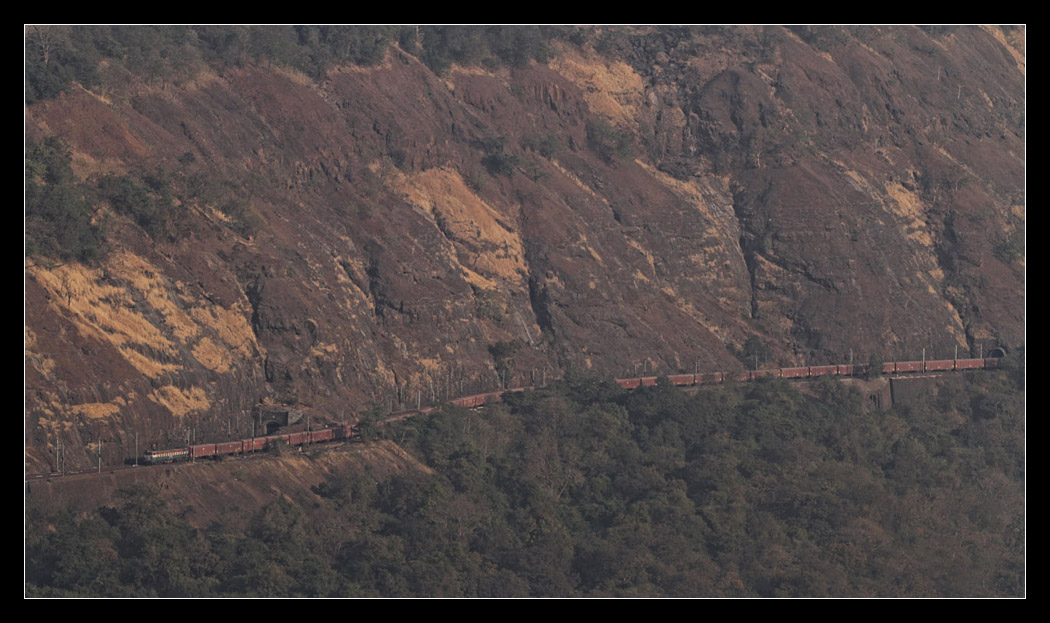
Units of two to three bankers were added to every uphill train at Karjat and uncoupled at Lonavla, no matter how long or short the train.

The mountainside presented itself as a spectacular mix of cake layers.

The train in its full glory entered the viaduct shortly before reaching Monkey Hill.
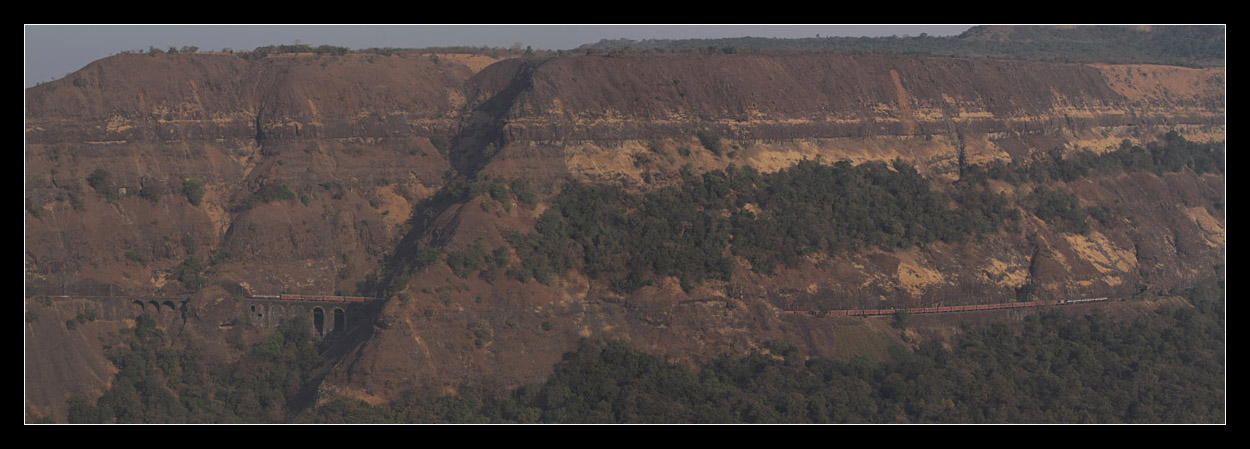

WAG-7 27213, 27209 and 27126 in banker duty, these AC locos had taken over from the WCG-2 class "Howlers" - due to their loud noise - , of which I only could witness one in low shunting duties at Mumbai CST.

Lalam waiting for the next train.
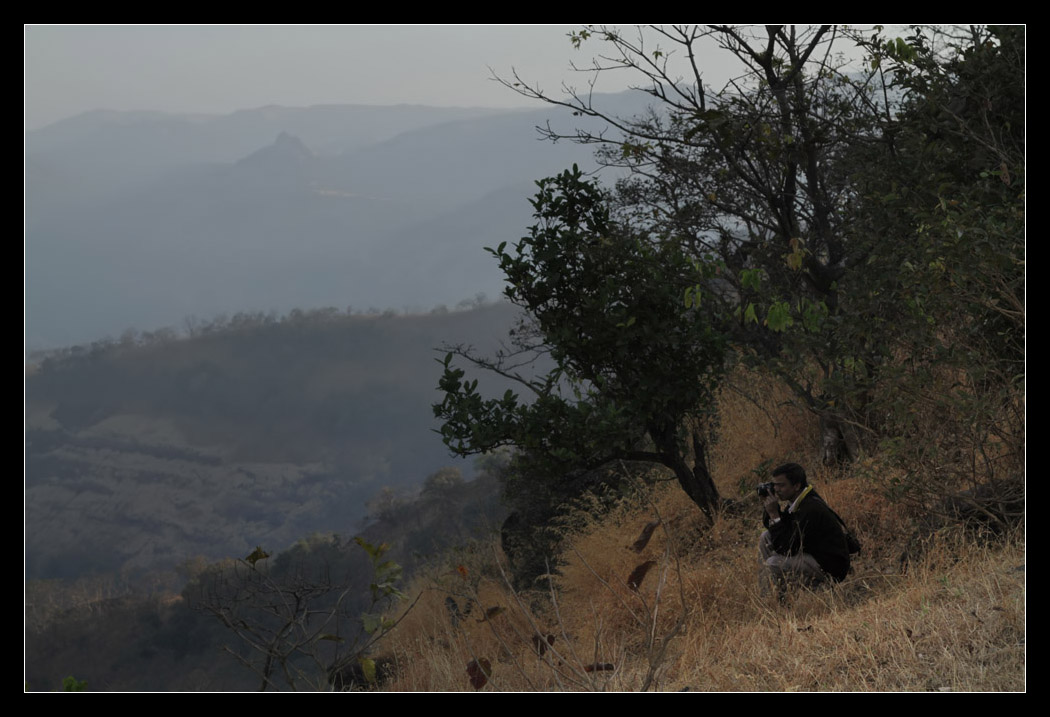
And here it came, Her Majesty, 12124 "Deccan Queen" Pune - Mumbai, the most famous daytime express of this route. This train had started operation as first "superfast" in India on June 1 1930, also it had been India's first long distance train with electric traction and the first featuring corridors inside coaches.
More about its history can be found here:
http://www.irfca.org/~shankie/famoustrains/famtraindqn.htm
Class WCAM-3 running downhill stopping the entirely Central Railway white-red-dark blue rake in front of prominent Monkey Hill for a brake test.

The mountain line had some unusual features, as on one hand it only exhibited steep grades into one direction because of the Deccan Plateau, on the other hand it ran right on the mountain's crest for a short distance near MHC - the cabin can be spotted to the left - , which is quite strange for a railway.

For express trains to Mumbai CST only dual current WCAM-3s came into question as electric locos because the last kilometres into the terminal still featured DC.
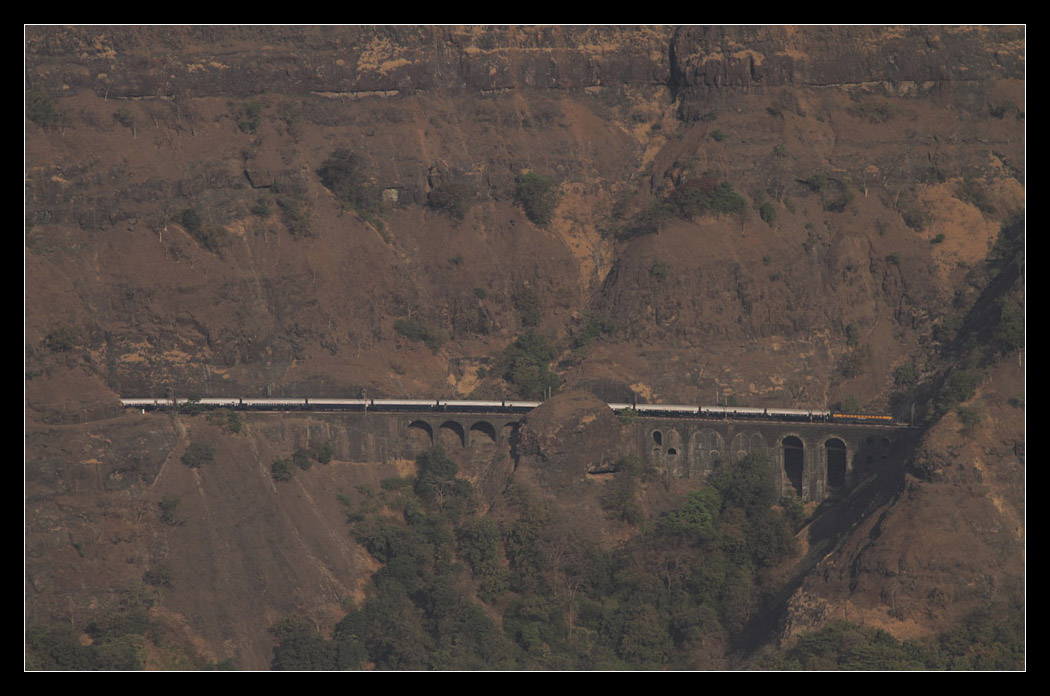


The Deccan Queen panorama of this spectacular valley.

Ashish had recorded it all on video.
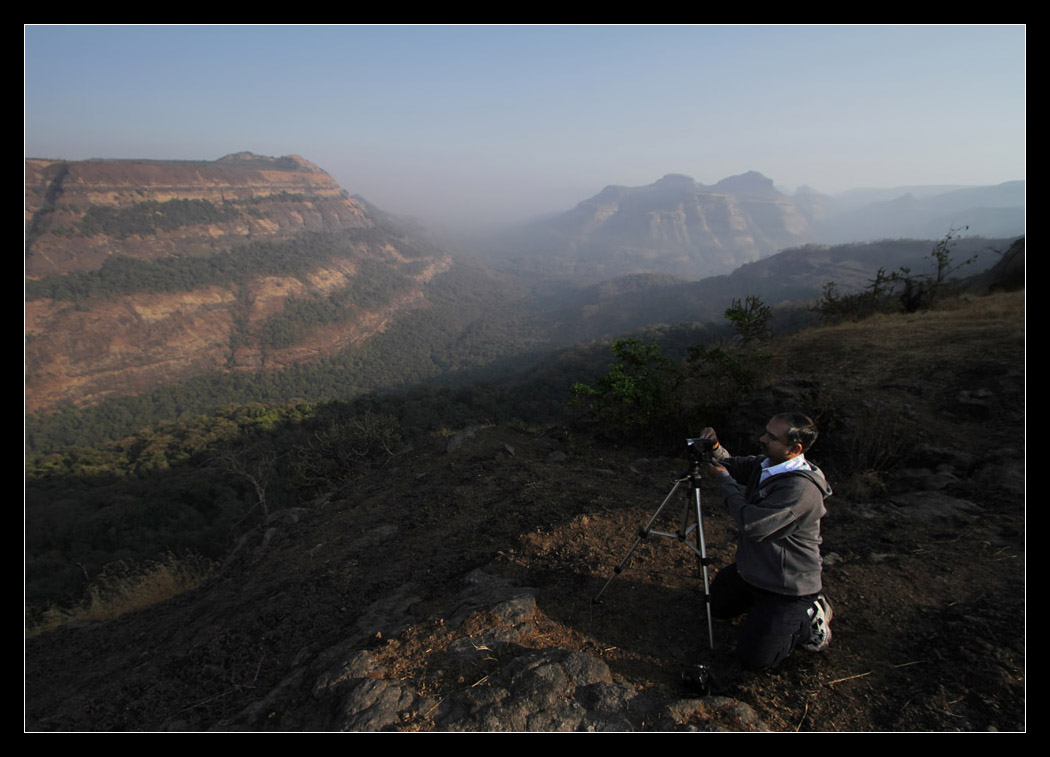
This was a mainline, soon afterwards the next Kalyan class WCAM-3 announced itself coming from Mumbai.

12127 Mumbai CST - Pune "Intercity Express", the counterpart to the "Deccan Queen" with morning departure from Mumbai and evening departure at Pune, managing the 192 kms between the centres in 3:07 hours.
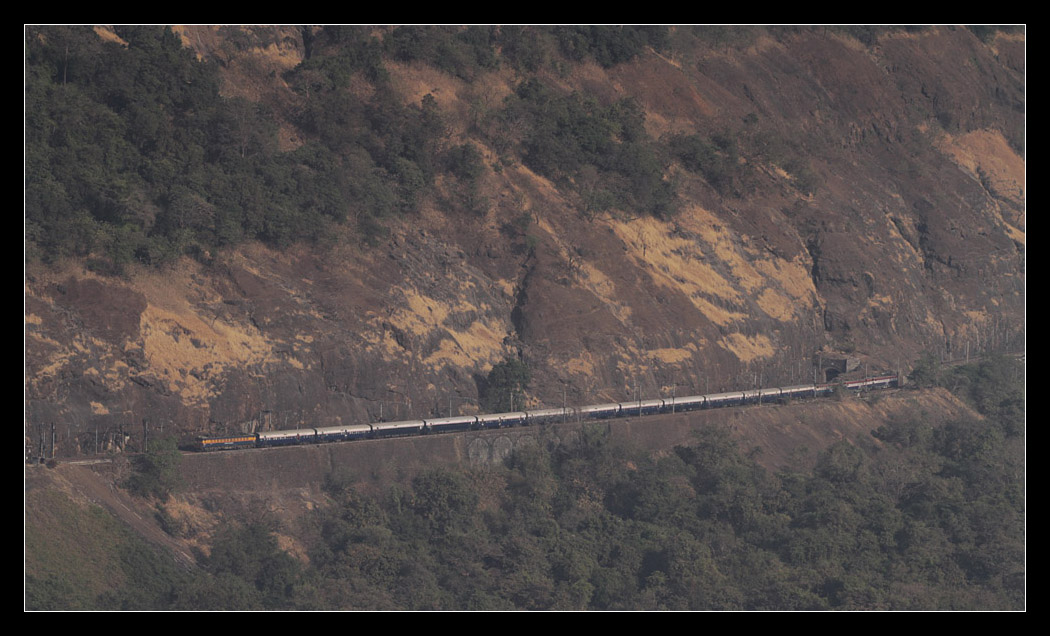
Kalyan freight locos WAG-7 27217, 27257 and 27118 banking a passenger train - an everyday sight on this line, everywhere else very rare.
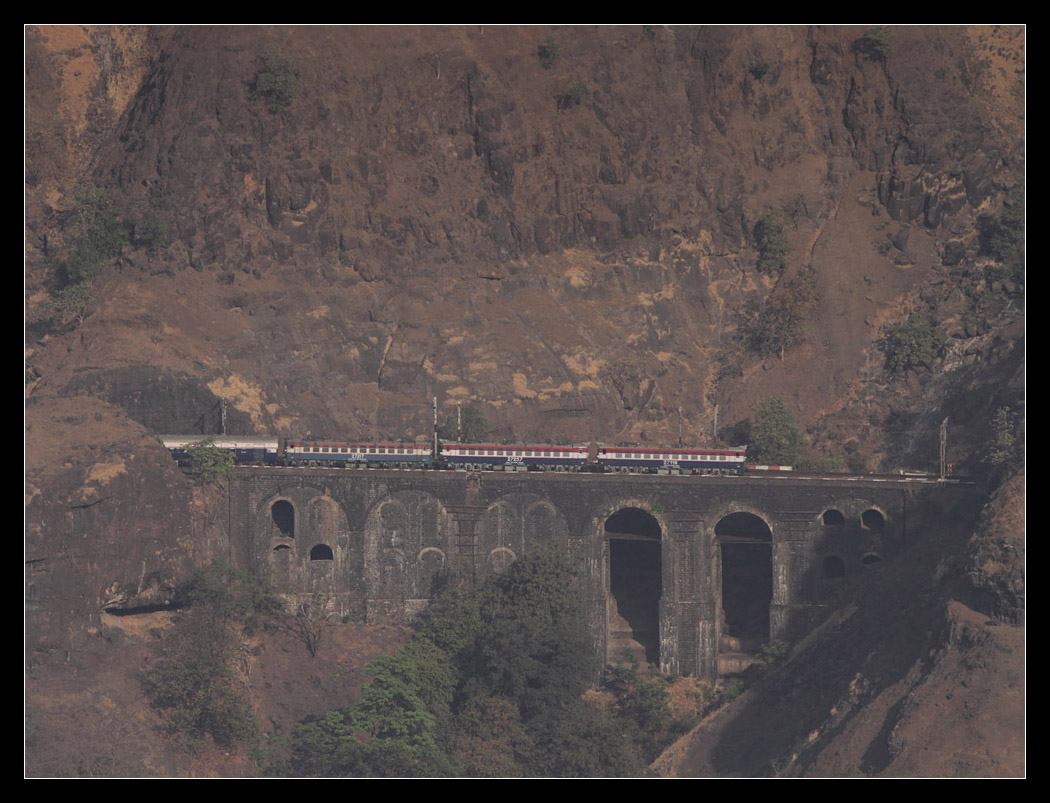
View at another cliff and Monkey Hill.
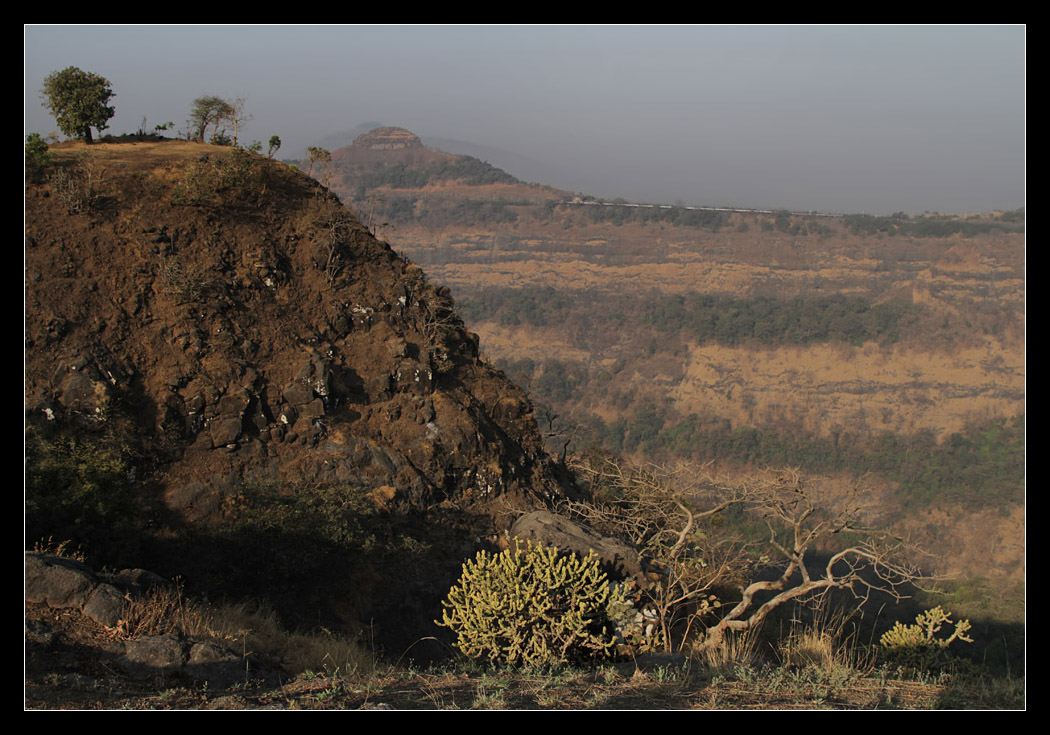
Apurva: Maybe try it from over there?

The panorama from the other spot, now Khandala was in view, one station ahead of Lonavla.

A cow herd offered an opportunity for a nice foreground.


12126 Pune - Mumbai CST "Pragati Express" followed half an hour behind "Deccan Queen" and passed the rustic MHC catch siding, which we were about to visit later.
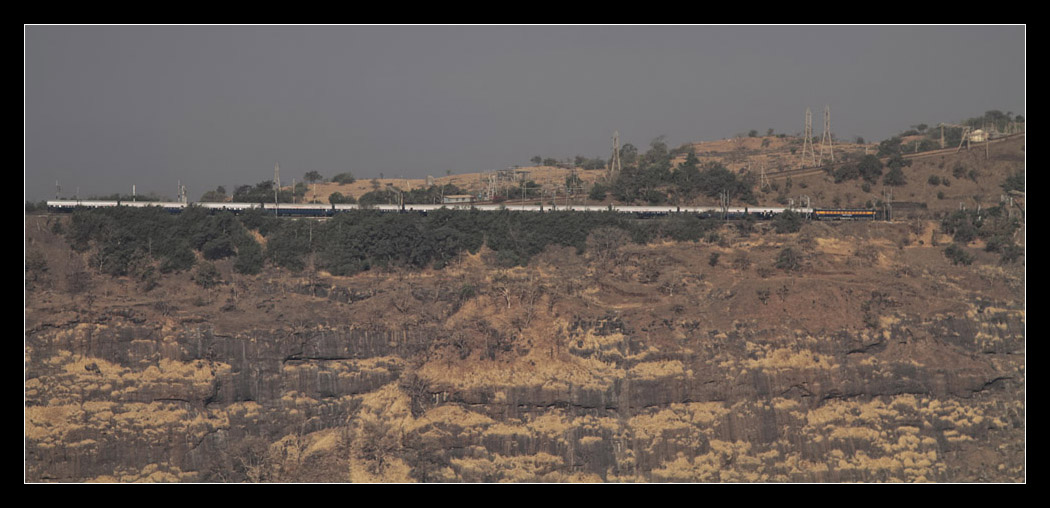

Apu had everything well in his sights.
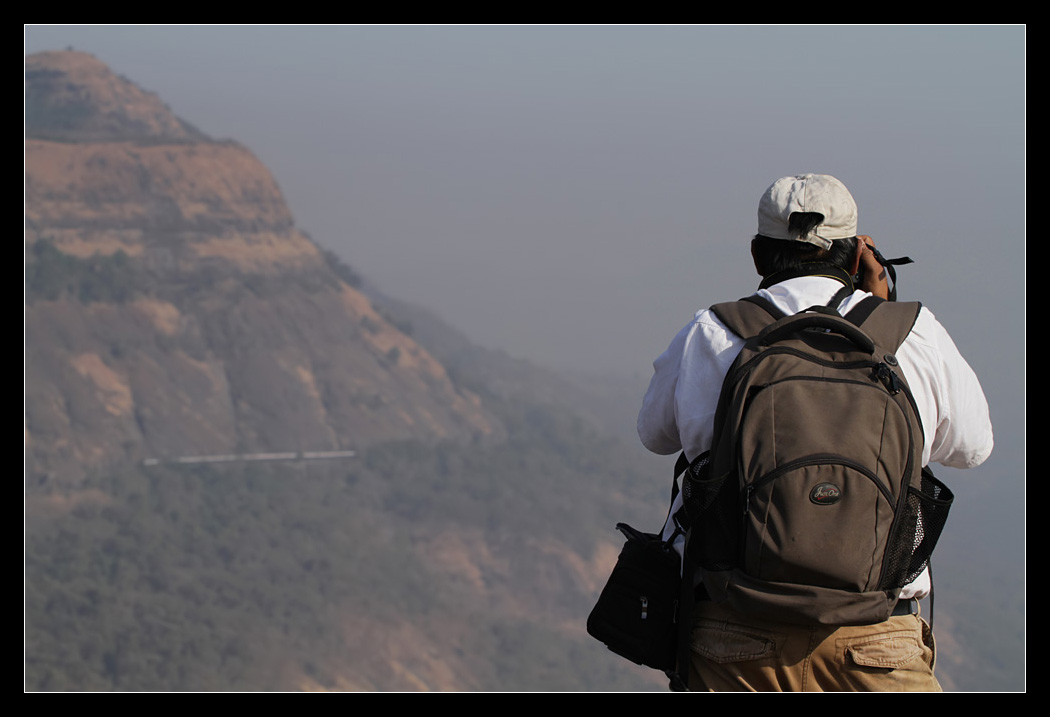

Ten minutes later followed the next highlight with 12220 Secunderabad - Lokmanya Tilak Terminus (Mumbai) "Duronto AC Express". The train class "Duronto" ( http://en.wikipedia.org/wiki/Duronto_Express ) was characterized by a non-stop ride from source to destination with only technical halts and no passenger exchange inbetween.
Gooty WDM-3D 11350 shortly stopped its modern German LHB-designed rake in colourful Duronto livery for a brake test.

As the name implicated this was a full AC rake with generator car behind the engine.


11024 Kolhapur - Mumbai CST "Sahyadri Express" followed.

At the same time 11007 Mumbai CST - Pune "Deccan Express" climbed the mountain from the other direction.

Almost a meeting, but "Sahyadri" took the third line on the other mountainside.

Now we had seen plenty - 6 express trains within 45 minutes - and moved back to the car. On the way we managed to capture another WAG-7 trio with cow herd.

Mansions were industriously constructed, inbetween locals let their cows graze. The workers sometimes lived right on the construction site, one unit of the shacks to the right could house a whole family!

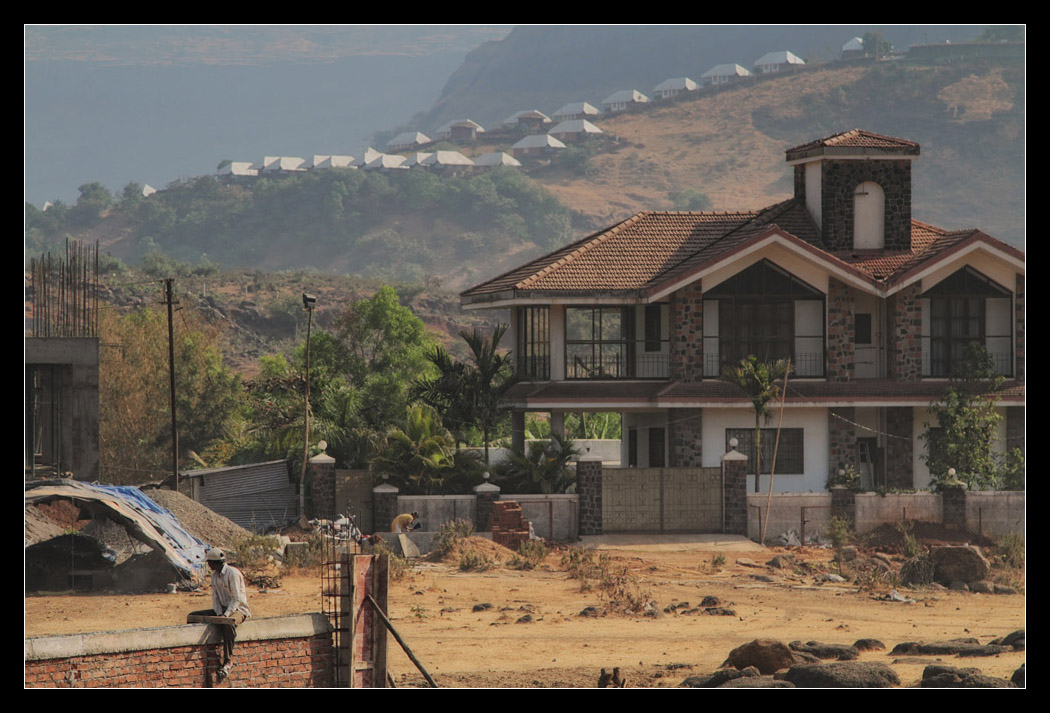
A short visit to Lonavla station followed. Ashish knew several people here including the station master, one of his photos decorated the control room. After a short, friendly introduction to the station master we moved to the Mumbai side station exit featuring a massive change of incline in the tracks. These were the last metres before reaching the top of the Deccan Plateau.
At Lonavla platform 1, on the tracks in the middle a banker trio was waiting.

At the northwestern station entrance.

Speeds had been increased once...
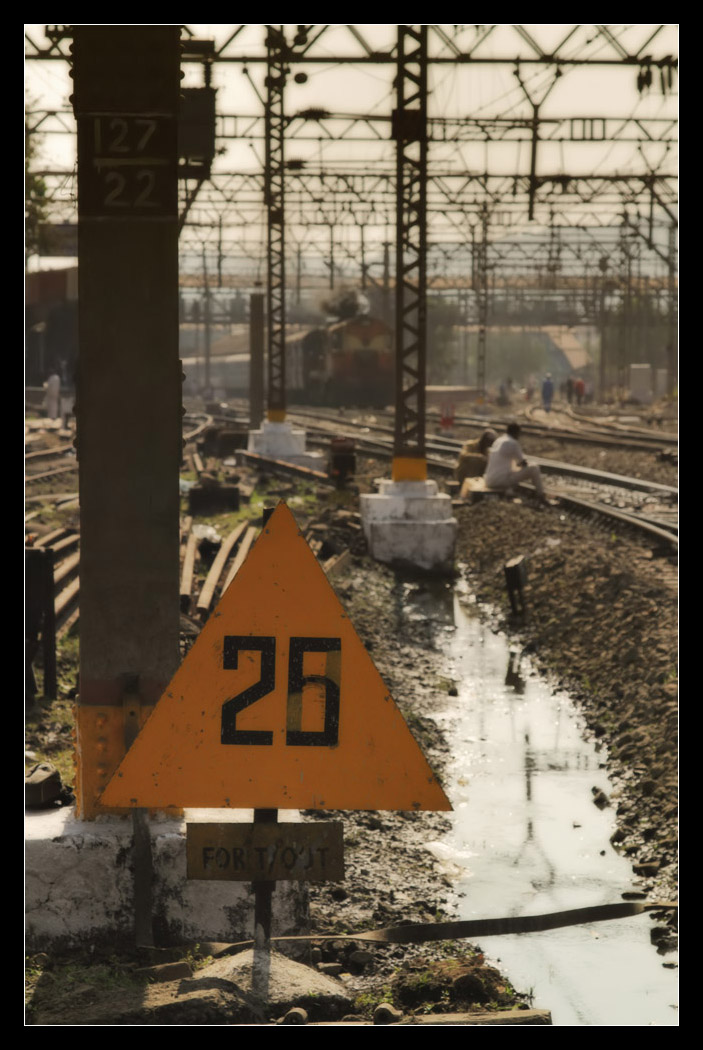
Two pausing track workers witnessed a mighty ALCO-spectacle by Kazipet WDM-3A 18890, once a specialized Rajdhani loco, now in general service.
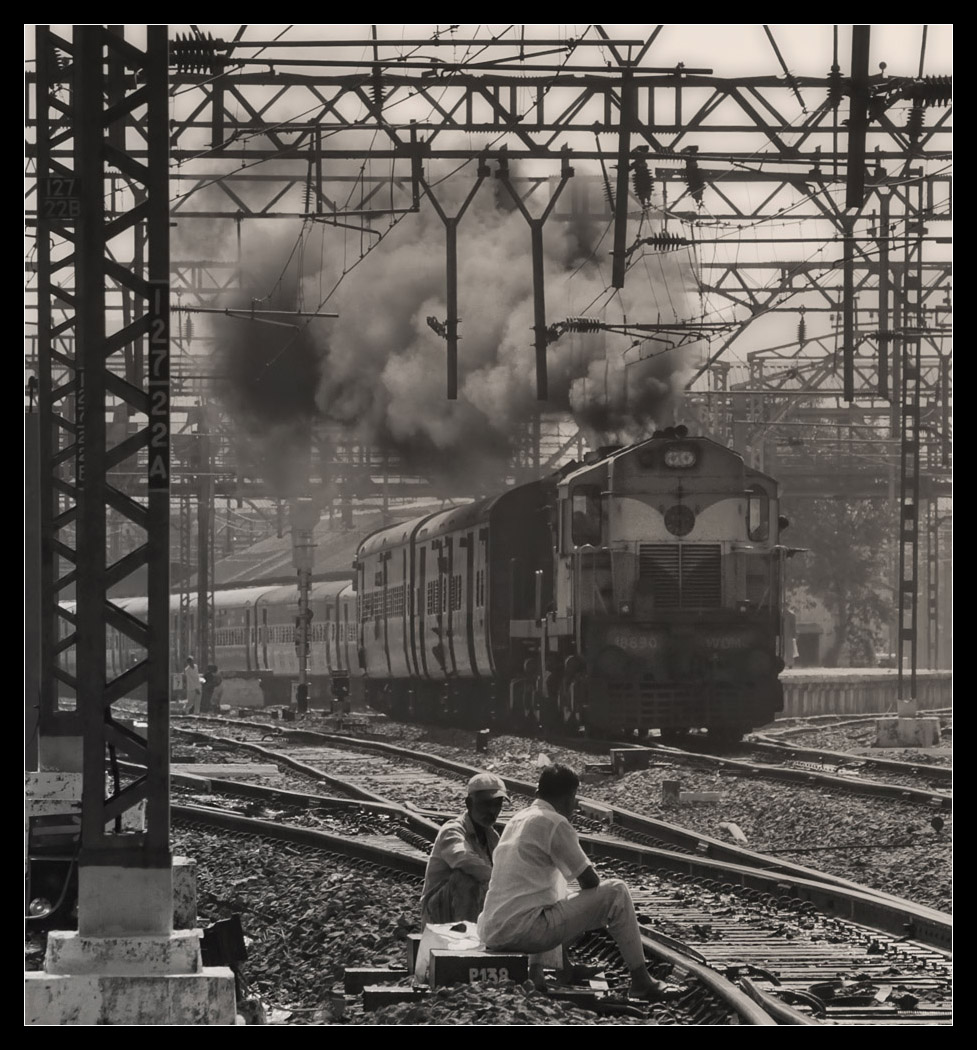
Despite of the steep downhill grade following right away, the loco had to accelerate fully with the long rake of 17032 Hyderabad - Mumbai CST express. The catenary masts still originated from the DC era.

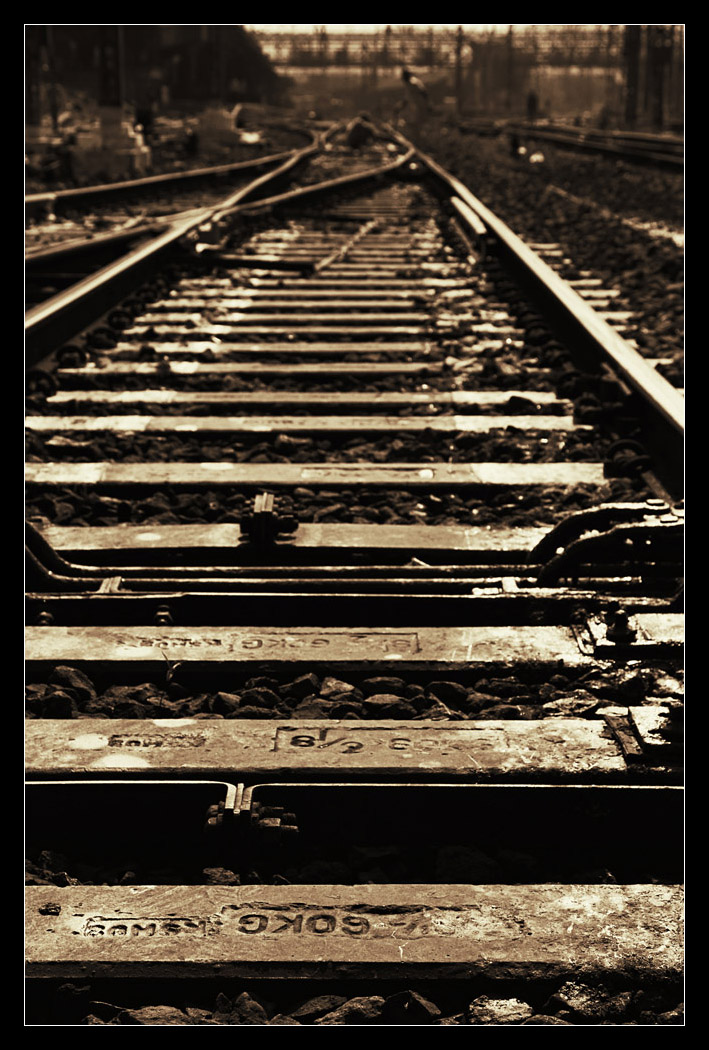
This "level crossing" seemed to be quite popular.

View into the station, now temperatures rose to European midsummer levels.

"Rock 'n' Roll" - GM approaching!
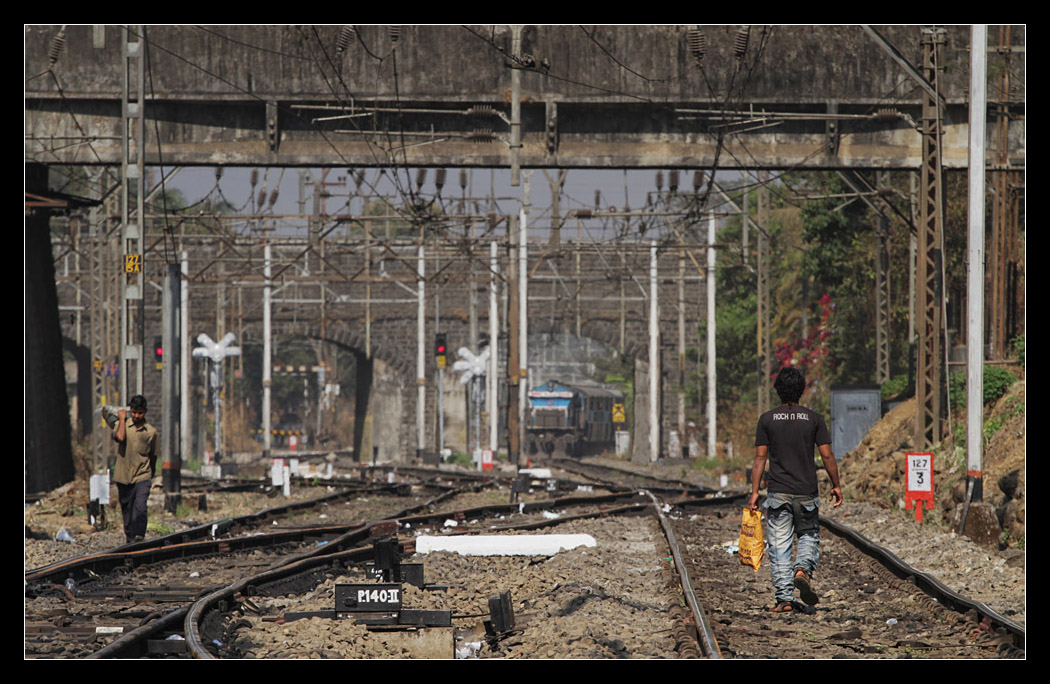

Krishnarajapuram (KJM) WDP-4 20025 hauled 16529 Mumbai - Bangalore "Udyan Express" uphill. If you look at the state of the footbridge you can see why that many people crossed the rails here...

A free rider ready to jump off "tigerface" WAG-7 27408 which had helped "Udyan Express" uphill with two colleagues.
We also jump off this report for now, continuing next time at Lonavla and Monkey Hill!

The previous trip report part:
India 2012 - 14: Thums Up for Ankai Killa! (50 p.)
http://railroadforums.com/forum/showthread.php?t=40077
The accompanying video:
http://www.youtube.com/watch?v=Ln9ntoVBVts&hd=1
February 14 2012
We continue our journey at Manmad where Sachin and Anish had taken me back to town. We parked behind the station where loco crew quarters and other railway buildings were located. Friends of Anish were living here with an elderly doctor who wanted to get me to meditate. We tried to get past the hospitality and soon walked on to the platform.
The southern entrance of Manmad station was much more convenient than the overpopulated northern main entrance.

My first meeting with one of the main Central Railway workhorses in Mumbai region, dual current WCAM-3 21948, built in 1998. From the pedestrian bridge you had a good overview of Manmad station.

My train was the Tuesday only ALCO hauled 12132 express Shirdi Dadar, from April its whole route was supposed to be electrified. I said goodbye to my friends and subsequently could enjoy a ride in not too full AC II class.
Code:
12132 SAINAGAR DR EXPRESS
3 MMR Manmad Jn 11:25 11:30 5 CR 85 1
4 NK Nasik Road 12:28 12:30 2 CR 158 1
5 IGP Igatpuri 13:23 13:25 2 CR 208 1
6 KYN Kalyan Jn 14:45 14:50 5 CR 292 1I crossed the Western Ghats or Sahyadri for the first time that day, on the steep Thal (or Thull) Ghat section between Igatpuri and Kasara. This mountain range constitutes the western edge of the Deccan Plateau where the main chunk of India is located. A natural barrier which always had to be overcome by railways in early times on the way to the centre and east coast of India. The Thal Ghat mountain section had been opened by the Great Indian Peninsula Railway (GIPR: http://en.wikipedia.org/wiki/Great_Indian_Peninsula_Railway ) in 1865, until recently DC electrified Mumbai - Igatpuri, now AC was ruling the Ghats. As passenger you did not notice this section dominated by steep grades, tall bridges and tunnels that much as it featured hardly any narrow curves.
After a little more than three hours we reached Kalyan almost punctually, main junction of two Central Railway mountain routes northeast of Mumbai and also home shed of Central Railway electric mainline locos in the Mumbai area. It was a chaotic station, jam-packed with passengers, even the waiting room proved to be fuller as it also included Sleeper class travellers. Express trains into various parts of the country arrived every ten minutes, sometimes having to wait until the platform was vacated by the previous express. It seemed to be customary for IR to use as few platforms as possible - this also had positive sides, because frequent platform changes would result in a mad rush with crowds of these proportions. Other platforms were frequented by Mumbai suburban trains, mostly modern types in ugly purple with British-like yellow fronts. Luckily some of the classic EMUs still were in service, I would meet those again at the end of the trip. At last it was time for my Konark Express, which I would only use for a short bit of its long journey to the east coast in Orissa, once more I could enjoy a relatively empty AC II.
Code:
11019 KONARK EXPRESS
1 CSTM Mumbai CST First 15:10 CR 0 1
2 DR Dadar Cr 15:23 15:25 2 CR 9 1
3 KYN Kalyan Jn 16:05 16:10 5 CR 54 1
4 KJT Karjat 16:53 16:55 2 CR 100 1
5 LNL Lonavla 17:43 17:45 2 CR 128 1
6 PUNE Pune Jn 19:00 19:05 5 CR 192 1
37 BBS Bhubaneswar 04:25 Last Stn ECOR 1932 3Now I could experience the Bhor Ghats ( http://en.wikipedia.org/wiki/Bhor_Ghat ) between Karjat and Lonavla. This line had been opened in 1861, however, not yet in the current state as in those days the mountains could only be conquered using switchbacks. I was about to explore this area in more detail with my Pune friends the next day. Shortly before sunset my train passed Kamshet which I also would be visiting 24 hours later. Sometimes faster, sometimes slower the train now crept into the juggernaut Pune, alternatingly showing Western and then again rustic Indian sides. At the main station I arrived close to the exit, yet I had to cross to the other side and even used an escalator for that. I asked for directions at the tuk-tuk stand and within minutes I had reached my hotel, a nicer business class one, on foot.
February 15 2012
That morning my friend Apurva - about the nicest man you will ever meet! - picked me up shortly after six. Lalam was also part of the group and finally Ashish joined us soon afterwards at a suburban station. We took Apurva's Tata Nano on the Mumbai Pune Expressway up to Lonavla, the Pune side end of the Ghat section. After breakfast in a restaurant we turned into a smaller street with horrible surface, however, the houses alongside it were far from bad. This hill station at 600 metres elevation was highly popular with Mumbaikars as excursion destination as well as location for holiday homes. The villas of the rich were sprouting out of the hillsides, but the local population hardly profited from this development. The street was also leading to "Indias largest adventure park", but we turned left before and parked at the end of the road.
Here:
http://g.co/maps/njhpu
The Tata Nano, the original version was supposed to be sold for 100000 rupees (about 1500 euros) upon launch, this more expensive version sported additional extras. In the street you noticed by the looks it was getting that it embodied a dream car for many Indians, as it would be affordable in their lifetime, yet practical and astonishingly good for its price. Apurva noticed that it really was fun to drive. Within the next years an export version is being planned.

We wandered through a narrow strip of forest where on one hand you had to be careful with snakes during monsoon time - now none could be seen - on the other hand it was used by the locals as a toilet. But overcoming this obstacle paid off - the Pune railfans had found a magnificent panorama spot opposite Monkey Hill Cabin (MHC). Here, trains stopped for brake tests before continuing downhill towards Mumbai. As soon as you had emerged from the woods a breathtaking view presented itself, with two lines to Monkey Hill leading along rock cliffs over viaducts and through tunnels, while a third line took the other side of the mountain.
Just at that moment WAG-7 27508 pulled a freight train uphill towards Pune. Only a short time ago this scene would have been impossible as this had been DC territory. Still, no AC locos could be witnessed hauling long distance express trains as electrification ended at Pune.

Units of two to three bankers were added to every uphill train at Karjat and uncoupled at Lonavla, no matter how long or short the train.

The mountainside presented itself as a spectacular mix of cake layers.

The train in its full glory entered the viaduct shortly before reaching Monkey Hill.


WAG-7 27213, 27209 and 27126 in banker duty, these AC locos had taken over from the WCG-2 class "Howlers" - due to their loud noise - , of which I only could witness one in low shunting duties at Mumbai CST.

Lalam waiting for the next train.

And here it came, Her Majesty, 12124 "Deccan Queen" Pune - Mumbai, the most famous daytime express of this route. This train had started operation as first "superfast" in India on June 1 1930, also it had been India's first long distance train with electric traction and the first featuring corridors inside coaches.
More about its history can be found here:
http://www.irfca.org/~shankie/famoustrains/famtraindqn.htm
Class WCAM-3 running downhill stopping the entirely Central Railway white-red-dark blue rake in front of prominent Monkey Hill for a brake test.

The mountain line had some unusual features, as on one hand it only exhibited steep grades into one direction because of the Deccan Plateau, on the other hand it ran right on the mountain's crest for a short distance near MHC - the cabin can be spotted to the left - , which is quite strange for a railway.

For express trains to Mumbai CST only dual current WCAM-3s came into question as electric locos because the last kilometres into the terminal still featured DC.



The Deccan Queen panorama of this spectacular valley.

Ashish had recorded it all on video.

This was a mainline, soon afterwards the next Kalyan class WCAM-3 announced itself coming from Mumbai.

12127 Mumbai CST - Pune "Intercity Express", the counterpart to the "Deccan Queen" with morning departure from Mumbai and evening departure at Pune, managing the 192 kms between the centres in 3:07 hours.

Kalyan freight locos WAG-7 27217, 27257 and 27118 banking a passenger train - an everyday sight on this line, everywhere else very rare.

View at another cliff and Monkey Hill.

Apurva: Maybe try it from over there?

The panorama from the other spot, now Khandala was in view, one station ahead of Lonavla.

A cow herd offered an opportunity for a nice foreground.


12126 Pune - Mumbai CST "Pragati Express" followed half an hour behind "Deccan Queen" and passed the rustic MHC catch siding, which we were about to visit later.


Apu had everything well in his sights.


Ten minutes later followed the next highlight with 12220 Secunderabad - Lokmanya Tilak Terminus (Mumbai) "Duronto AC Express". The train class "Duronto" ( http://en.wikipedia.org/wiki/Duronto_Express ) was characterized by a non-stop ride from source to destination with only technical halts and no passenger exchange inbetween.
Gooty WDM-3D 11350 shortly stopped its modern German LHB-designed rake in colourful Duronto livery for a brake test.

As the name implicated this was a full AC rake with generator car behind the engine.


11024 Kolhapur - Mumbai CST "Sahyadri Express" followed.

At the same time 11007 Mumbai CST - Pune "Deccan Express" climbed the mountain from the other direction.

Almost a meeting, but "Sahyadri" took the third line on the other mountainside.

Now we had seen plenty - 6 express trains within 45 minutes - and moved back to the car. On the way we managed to capture another WAG-7 trio with cow herd.

Mansions were industriously constructed, inbetween locals let their cows graze. The workers sometimes lived right on the construction site, one unit of the shacks to the right could house a whole family!


A short visit to Lonavla station followed. Ashish knew several people here including the station master, one of his photos decorated the control room. After a short, friendly introduction to the station master we moved to the Mumbai side station exit featuring a massive change of incline in the tracks. These were the last metres before reaching the top of the Deccan Plateau.
At Lonavla platform 1, on the tracks in the middle a banker trio was waiting.

At the northwestern station entrance.

Speeds had been increased once...

Two pausing track workers witnessed a mighty ALCO-spectacle by Kazipet WDM-3A 18890, once a specialized Rajdhani loco, now in general service.

Despite of the steep downhill grade following right away, the loco had to accelerate fully with the long rake of 17032 Hyderabad - Mumbai CST express. The catenary masts still originated from the DC era.


This "level crossing" seemed to be quite popular.

View into the station, now temperatures rose to European midsummer levels.

"Rock 'n' Roll" - GM approaching!


Krishnarajapuram (KJM) WDP-4 20025 hauled 16529 Mumbai - Bangalore "Udyan Express" uphill. If you look at the state of the footbridge you can see why that many people crossed the rails here...

A free rider ready to jump off "tigerface" WAG-7 27408 which had helped "Udyan Express" uphill with two colleagues.
We also jump off this report for now, continuing next time at Lonavla and Monkey Hill!

